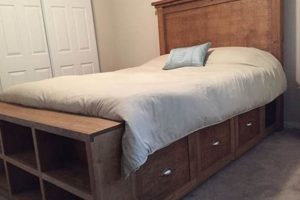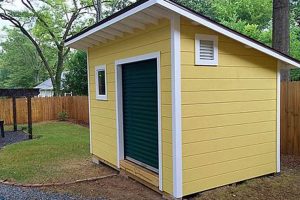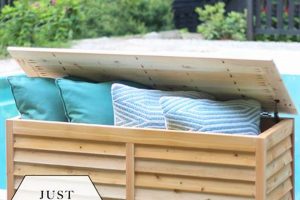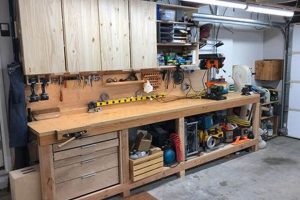A project involving the creation of a combined seating and storage unit, often utilizing readily available materials and basic carpentry techniques, provides a practical solution for space optimization. An example includes constructing a wooden structure with a hinged lid, allowing interior access for storing items while simultaneously serving as a bench.
This type of project offers several advantages, including enhanced organization within a dwelling, reduced clutter, and the potential for cost savings compared to purchasing pre-made furniture. Historically, similar projects have been undertaken to maximize limited living spaces and repurpose existing materials, demonstrating a commitment to resourcefulness and functional design.
The following sections will detail various approaches to constructing these units, explore material selection considerations, and outline essential techniques for ensuring structural integrity and aesthetic appeal.
Crafting Durable and Functional Seating with Integrated Storage
This section provides key insights for the successful creation of a combined seating and storage solution, focusing on longevity, structural soundness, and practical usability. Adherence to these guidelines enhances the final product’s utility and lifespan.
Tip 1: Material Selection is Paramount: Opt for hardwood lumber, such as oak or maple, for load-bearing components to ensure structural integrity. Softwoods, like pine, may be suitable for less critical elements, but require careful joint construction and reinforcement. Pressure-treated lumber is essential for projects exposed to moisture.
Tip 2: Precise Measurements and Planning are Crucial: Create detailed diagrams outlining dimensions, material quantities, and joint placement before commencing construction. Accurate measurements minimize errors and material waste. Consider the intended storage capacity and user weight when determining dimensions.
Tip 3: Joint Strength Determines Longevity: Employ robust joinery techniques, such as mortise and tenon, dovetails, or reinforced butt joints with screws and glue, to withstand repeated use and weight. Avoid relying solely on nails or staples for structural connections.
Tip 4: Lid Support Mechanisms Enhance Safety and Functionality: Incorporate hinges with soft-close mechanisms or gas struts to prevent sudden lid closures and provide controlled opening and closing. This feature reduces the risk of injury and prolongs the hinge lifespan.
Tip 5: Surface Treatment Protects and Enhances Aesthetics: Apply a durable finish, such as polyurethane or varnish, to protect the wood from moisture, scratches, and UV damage. Consider multiple coats for increased protection and a smoother surface. Choose a finish that complements the surrounding dcor.
Tip 6: Internal Dividers Optimize Organization: Integrate internal dividers or compartments to facilitate organized storage within the unit. These dividers can be fixed or adjustable, depending on the intended use. Consider the size and shape of items to be stored when designing the internal layout.
These considerations contribute significantly to the creation of a functional and enduring piece of furniture. By focusing on material selection, precise construction, and appropriate finishing techniques, the resulting unit will provide years of reliable service.
The subsequent sections will explore specific design options and address common challenges encountered during the construction process.
1. Structural Integrity
Structural integrity is a paramount consideration in combined seating and storage construction, directly impacting user safety and the unit’s longevity. Inadequate structural design can lead to catastrophic failure under load, resulting in injury or property damage. The inherent function of the combined unit, supporting weight while simultaneously housing stored items, necessitates robust construction methods.
The connection between structural soundness and successful seating and storage construction is causal. Weak joints or insufficient material thickness will inevitably result in deformation, cracking, or complete collapse under the combined stress of seating and storage. Examples of insufficient construction include using thin plywood for the primary support structure, relying solely on nails without adhesive for joint reinforcement, or neglecting to account for weight distribution when planning the design. Conversely, proper execution, incorporating load-bearing hardwoods, robust joinery techniques (e.g., mortise and tenon), and adequate support bracing, significantly enhances the unit’s capacity to withstand stress and maintain its form over time.
Therefore, ensuring structural integrity is not merely an aesthetic consideration but a fundamental requirement for safe and functional combined seating and storage. Prioritizing sound construction techniques mitigates potential hazards and maximizes the lifespan of the completed project. The application of engineering principles, even at a basic level, is beneficial in assessing load distribution and selecting appropriate materials and construction methods to achieve the desired level of structural stability.
2. Material Selection
Material selection critically influences the structural integrity, longevity, and aesthetic appeal of a storage bench project. The cause-and-effect relationship is direct: selecting inappropriate materials will result in a compromised final product. Conversely, judicious material choices contribute to a functional and durable combined seating and storage solution.
The importance of careful material selection stems from the dual function of a storage bench, bearing weight as seating and containing stored items. For example, constructing the frame from softwood, such as pine, without adequate reinforcement will likely lead to sagging or structural failure under load. Conversely, utilizing hardwood, like oak or maple, for the frame provides superior strength and resistance to deformation. Similarly, selecting moisture-resistant materials, such as cedar or treated lumber, is essential for units intended for outdoor use, preventing rot and extending the lifespan. The material used for the bench seat also affects user comfort. A solid wood seat provides a sturdy and durable surface, while a padded seat offers increased comfort. The choice often depends on the bench’s intended use and location. The hardware used, such as hinges and latches, must also be durable and corrosion-resistant to withstand repeated use and exposure to the elements.
In summary, material selection is not merely a preliminary step but a fundamental determinant of a storage bench project’s success. Understanding the properties of various materials and their suitability for specific applications is crucial for creating a functional, durable, and aesthetically pleasing piece of furniture. Neglecting this aspect compromises the entire project, whereas informed material choices ensure a positive outcome.
3. Joint Construction
Joint construction is a foundational element in combined seating and storage, directly influencing the structural integrity and longevity of the project. Inadequate jointing methods inevitably lead to instability and premature failure, rendering the unit unusable. The correlation between robust joint construction and successful implementation is causal; stronger joints yield a more durable and reliable seating and storage solution. For instance, a simple butt joint secured only with nails is insufficient for load-bearing applications, whereas a mortise and tenon joint or a rabbet joint reinforced with adhesive and screws provides significantly enhanced strength and resistance to stress.
The selection of appropriate jointing techniques is dependent upon several factors, including the type of materials used, the intended load capacity, and the overall design of the unit. Dovetail joints, for example, offer exceptional tensile strength and are particularly well-suited for connecting drawer boxes or other components subjected to pulling forces. Pocket hole joinery, while simpler to execute, is suitable for less critical connections where aesthetic considerations are secondary to ease of assembly. An understanding of these diverse jointing methods allows the builder to optimize the design for both structural integrity and efficient construction. Failure to correctly execute joints, like incorrect glue application or loose screws, will compromise even the best joint design.
In conclusion, proper joint construction is not merely an ancillary detail but a critical determinant of the finished unit’s functionality and lifespan. A thorough understanding of various jointing techniques, coupled with careful execution, is essential for creating a sturdy and enduring combined seating and storage solution. The investment of time and effort in mastering these skills translates directly into a more robust and reliable piece of furniture that can withstand the rigors of daily use.
4. Design Planning
Design planning forms the bedrock upon which a successful storage bench construction rests. The absence of a comprehensive design precipitates functional deficiencies, structural instability, and aesthetic incongruities. The relationship between detailed design planning and a positive outcome in a storage bench project is causal. Without a plan, material wastage increases, construction errors proliferate, and the final product often fails to meet the intended requirements.
The design phase necessitates a meticulous consideration of dimensions, material selection, jointing methods, and ergonomic factors. For example, failure to accurately measure the intended location of the storage bench may result in a unit that is too large or too small for the space. Similarly, neglecting to consider the weight capacity of the bench during the design process could lead to structural failure under load. The inclusion of internal dividers, adjustable shelves, or other organizational features requires careful planning to maximize storage efficiency and usability. Ergonomic factors, such as seat height and backrest angle (if applicable), must be addressed to ensure user comfort. Real-world examples demonstrate that storage benches built without adequate design planning frequently exhibit uneven surfaces, unstable legs, and lids that do not align properly. These defects not only detract from the aesthetic appeal but also compromise the unit’s functionality and safety.
In summary, design planning is not a peripheral element but an indispensable component of a successful storage bench undertaking. A well-conceived design mitigates risks, optimizes material usage, and ensures that the final product is both functional and aesthetically pleasing. Overlooking this critical phase leads to avoidable errors, increased costs, and a storage bench that fails to meet expectations. The practical significance lies in the creation of a durable, functional, and visually harmonious piece of furniture tailored to specific needs and spatial constraints.
5. Functionality
The term ‘functionality’, when applied to combined seating and storage construction, refers to its capacity to effectively fulfill its intended purposes: providing a seating surface and offering enclosed storage space. The degree to which this purpose is met directly dictates the practical value and usability of the finished item. Poor design choices impacting accessibility, weight capacity, or organizational efficiency diminish the unit’s overall utility. For example, a unit with a seat height that is too low or too high will be uncomfortable to use, negating the seating aspect. Similarly, inadequate storage space or difficult-to-access compartments will render the storage function ineffective. The cause-and-effect relationship is clear: diminished functionality translates directly into decreased usefulness.
Real-world applications demonstrate the importance of designing with functionality in mind. A well-planned storage bench positioned in an entryway, for instance, can provide a convenient location for storing shoes, hats, and gloves, thereby reducing clutter and improving organization. The bench’s seating function then provides a comfortable spot for putting on or taking off footwear. Conversely, a poorly designed storage bench with a narrow seat, a heavy, difficult-to-open lid, and inaccessible storage compartments will likely be relegated to infrequent use or abandoned altogether. The hinge system used to secure the lid is also a factor. It not only must support the weight of the seat for both storage and safety for the user of the bench, in the opening and closing.
In conclusion, functionality is a critical component, and must be thoughtfully considered during the planning and construction phases. Prioritizing ease of use, storage capacity, accessibility, and user comfort ensures that the finished product serves its intended purpose effectively. Failing to address these considerations compromises the unit’s value and ultimately undermines the time and effort invested in its creation. A balance between form and function allows the user to be aesthetically pleased as well as efficient. A thoughtful assessment of storage needs and seating requirements is essential for creating a truly functional and valuable addition to any living space.
6. Aesthetic Finish
The aesthetic finish is a crucial element in the completion of a combined seating and storage unit, directly influencing its integration into a designated environment. This aspect extends beyond mere visual appeal; it impacts the perceived value, durability, and overall satisfaction derived from the project. The application of an appropriate finish protects the underlying material from wear and tear, moisture, and ultraviolet radiation, thereby prolonging its lifespan. Without a protective finish, the raw material is susceptible to damage, diminishing both its appearance and structural integrity. The choice of finish, including paint, stain, varnish, or oil, should be guided by the intended use of the unit, the type of material employed, and the desired aesthetic effect. Improper surface preparation or application techniques can lead to uneven coverage, peeling, or other imperfections, detracting from the overall quality of the piece.
Real-world examples illustrate the importance of a well-executed finish. A storage bench intended for outdoor use necessitates a weather-resistant finish, such as marine varnish or exterior-grade paint, to withstand exposure to the elements. An indoor unit, on the other hand, may benefit from a more subtle finish, such as a stain and clear coat, to highlight the natural grain of the wood. The application of multiple coats, with proper sanding between each layer, is generally recommended to achieve a smooth, durable, and visually appealing surface. Color selection is also an important part of the aesthetic finish. The finish color may coordinate with surrounding furniture.
In summary, the aesthetic finish is not merely a cosmetic consideration but an integral component of combined seating and storage construction. A well-chosen and properly applied finish protects the underlying material, enhances its visual appeal, and contributes to the overall value and longevity of the finished piece. Overlooking this aspect undermines the quality and durability of the project. A thorough understanding of finishing techniques and material compatibility is essential for achieving a professional-grade result that seamlessly integrates into its intended setting.
7. Space Optimization
The connection between space optimization and combined seating and storage construction is fundamental. This is particularly relevant in dwellings where square footage is limited, or where maximizing the functionality of a given area is desired. Space optimization, therefore, is not merely a desirable attribute but often the primary impetus behind undertaking such projects. The efficiency with which the combined unit serves both seating and storage functions directly correlates with the degree of space optimization achieved. A poorly designed unit that occupies excessive floor space or offers inefficient storage diminishes the potential benefits. Conversely, a thoughtfully planned design that integrates seamlessly into its surroundings and maximizes available storage contributes significantly to a more organized and functional living environment.
Real-world examples underscore the significance of space optimization in this context. Consider a small apartment where conventional furniture would overwhelm the available space. A combined seating and storage unit, strategically placed, can provide seating while simultaneously storing items such as linens, books, or seasonal clothing. This dual functionality reduces the need for separate pieces of furniture, thereby freeing up valuable floor space. In entryways, these units serve as both a bench for removing shoes and a storage solution for outerwear, effectively consolidating two functions into one. In children’s bedrooms, they offer seating and toy storage, helping to maintain a tidy and organized play area.
In conclusion, space optimization is an intrinsic component of successful combined seating and storage construction. Achieving this requires careful consideration of dimensions, storage needs, and the overall design of the unit. While challenges may arise in balancing functionality with aesthetics, prioritizing space efficiency ensures that the finished product provides a tangible benefit in terms of organization and usable living space.
Frequently Asked Questions
The following addresses common inquiries regarding the construction of combined seating and storage units. Clarification of these points promotes informed decision-making and successful project execution.
Question 1: What is the optimal wood type for ensuring structural stability in a combined seating and storage project?
Hardwoods, such as oak or maple, are generally preferred for load-bearing components due to their superior strength and resistance to deformation. Softwoods may be used for less critical elements, provided that appropriate joinery techniques and reinforcement are employed.
Question 2: What are the most common mistakes made during storage bench construction, and how can they be avoided?
Common errors include inadequate joint construction, insufficient material thickness, and inaccurate measurements. These can be mitigated through careful planning, precise execution, and adherence to established woodworking principles.
Question 3: How should the dimensions of a storage bench be determined to maximize both seating comfort and storage capacity?
Dimensions should be based on the intended users, the available space, and the types of items to be stored. Ergonomic considerations, such as seat height and depth, are essential for ensuring user comfort. An assessment of storage needs should guide the selection of appropriate internal dimensions and configurations.
Question 4: What safety precautions should be taken when constructing a storage bench, particularly concerning the lid mechanism?
Safety measures include using hinges with soft-close mechanisms or gas struts to prevent sudden lid closures, rounding sharp edges to minimize the risk of injury, and ensuring that the lid is securely attached to the frame to prevent accidental detachment.
Question 5: What are the maintenance requirements for a storage bench, and how can its lifespan be extended?
Maintenance requirements depend on the materials used and the intended use environment. Regular cleaning with appropriate products is essential. Periodic inspection of joints and hardware is recommended to identify and address any signs of wear or damage. Refinishing or reapplying protective coatings can prolong the lifespan of the unit.
Question 6: Can storage benches be effectively constructed using reclaimed or recycled materials, and what are the limitations?
Storage benches can be constructed using reclaimed or recycled materials, provided that the materials are structurally sound and free from hazardous substances. Limitations may include variations in material dimensions, potential aesthetic inconsistencies, and the need for additional preparation or modification.
Addressing these queries facilitates the creation of well-designed and properly constructed combined seating and storage projects. Careful consideration of these points enhances both the functionality and the longevity of the resulting unit.
The subsequent sections will delve into advanced design considerations and explore innovative approaches to constructing these units.
Conclusion
The preceding discussion has explored the multifaceted nature of combined seating and storage construction. From the fundamental aspects of structural integrity and material selection to the nuanced considerations of aesthetic finish and space optimization, each element contributes to the overall success of the project. The integration of these principles ensures the creation of a functional, durable, and aesthetically pleasing storage bench.
The meticulous execution of each stage of the construction processfrom design planning through final finishingdirectly influences the long-term value and utility of the finished product. Continued exploration and refinement of these techniques will lead to innovative solutions that further enhance the efficiency and aesthetic integration of combined seating and storage units within diverse environments.




![DIY Storage: Tote Rack DIY Plans & Ideas [Easy!] The DIY Hub: Creative Crafts, Repairs & Life Hacks DIY Storage: Tote Rack DIY Plans & Ideas [Easy!] | The DIY Hub: Creative Crafts, Repairs & Life Hacks](https://craftingdiycenter.com/wp-content/uploads/2025/07/th-1813-300x200.jpg)


